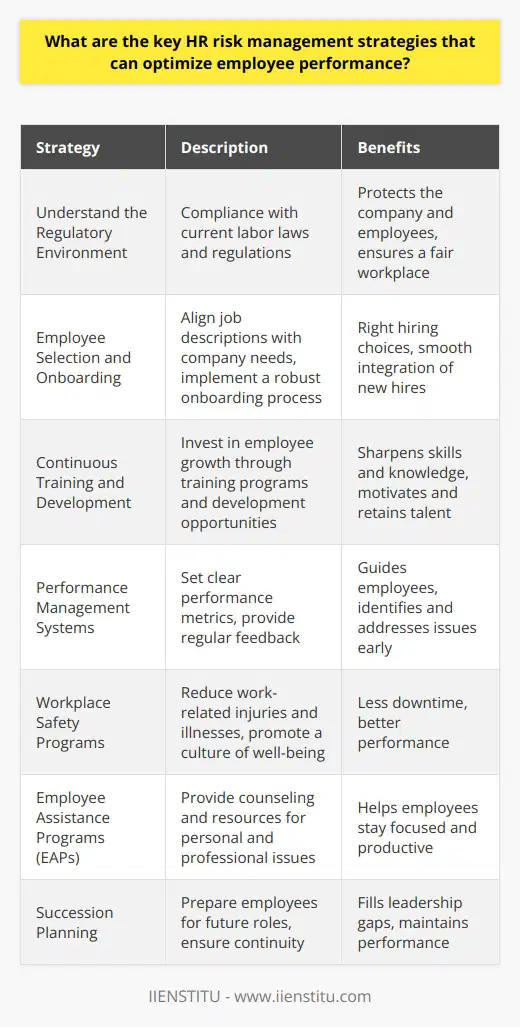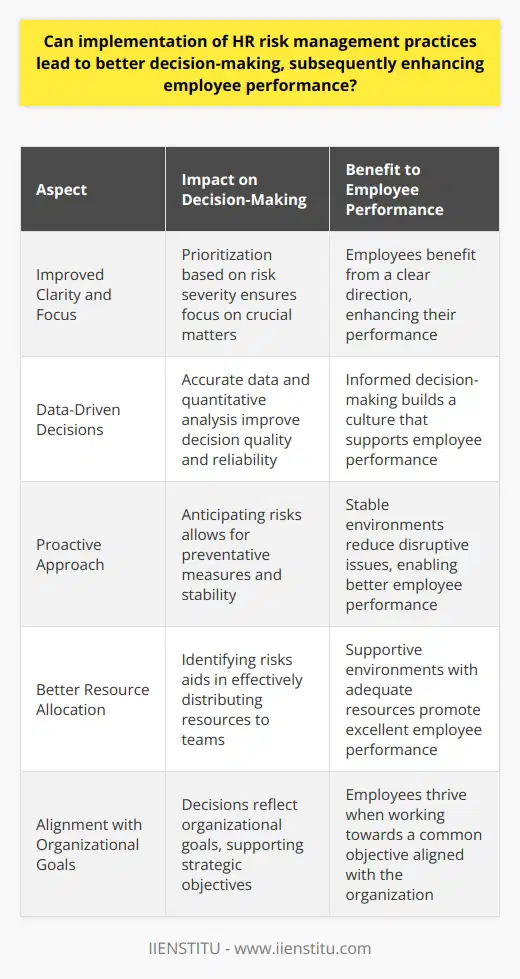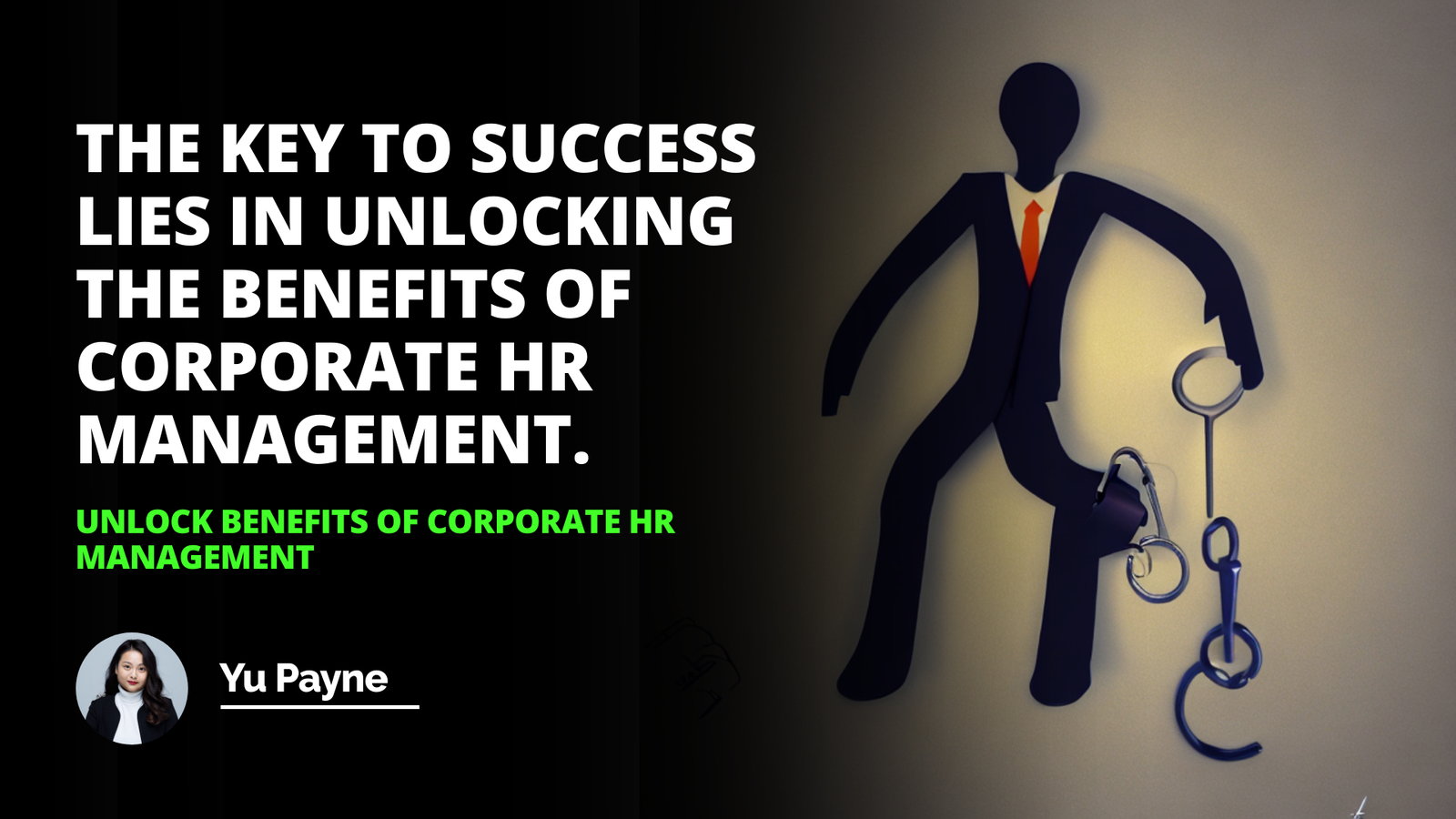
Being part of a team that has navigated the intricate world of Human Resources for over a decade, I've come to realize that HR risk management is much more than a corporate buzzword—it's the heartbeat of organizational resilience. Remember when our department faced the sudden departure of a key executive? That experience underscored how pivotal it is to anticipate and mitigate risks associated with our most valuable asset: our people.
Understanding HR Risk Management
At its core, HR risk management is a systematic process dedicated to identifying, assessing, and controlling threats that stem from human resources functions. It's not just about ticking compliance boxes; it's about crafting a strategic approach that aligns with the organization's overarching goals. I recall pouring over Armstrong's Handbook of Human Resource Management Practice (Armstrong, 2014), which emphasized that effective risk management in HR can be the linchpin in achieving optimal employee performance and driving organizational success.
The Multifaceted Role of HR in Risk Management
Human Resources isn't confined to administrative duties anymore. Today, HR professionals are strategic partners, collaborating across departments to weave risk management into the very fabric of business planning. This proactive stance allows us to foresee potential pitfalls. For instance, in one organization I worked with, HR collaborated with IT to address cybersecurity threats, particularly concerning employee data. By doing so, we not only protected sensitive information but also cultivated trust among employees.
Types of HR Risks
To tackle HR risks effectively, we first need to recognize them. Broadly, these risks fall into three categories:
1- Operational Risks: These involve day-to-day activities such as recruitment, training, and payroll management. Imagine a scenario where payroll errors consistently occur. This not only frustrates employees but can also lead to legal issues.
2- Strategic Risks: Decisions that affect the organization's future fall here. This includes choices about organizational culture, leadership development, or mergers and acquisitions. A misstep in cultural integration during a merger, for example, can result in high turnover rates.
3- Compliance Risks: Adherence to labor laws, regulations, and ethical standards is non-negotiable. Non-compliance can lead to hefty fines and reputational damage.
Approaches to HR Risk Management
When it comes to managing risks, I often think of it like navigating a ship through stormy seas. You need a solid plan and an attentive crew.
1. Risk Identification
The first step is spotting the possible icebergs ahead. This involves:
Conducting audits: Regular reviews of HR policies and practices help in detecting inconsistencies or outdated procedures.
Promoting open communication: Employees should feel comfortable voicing concerns. I remember implementing an anonymous feedback system, which revealed underlying issues in team dynamics that we hadn't been aware of.
2. Risk Assessment
Once risks are identified, we assess their potential impact:
Quantitative Measures: Estimating financial implications, like potential losses from employee turnover.
Qualitative Analyses: Gauging employee satisfaction through surveys. High dissatisfaction rates could predict an increase in resignations.
Balancing Creativity and Professionalism in Intern Recruitment: A Comprehensive Guide
HR Service Delivery: Optimizing Workforce Value in Modern Businesses
3. Risk Control and Mitigation
Here, we develop strategies to minimize risks:
Policy Implementation: Introducing clear guidelines on workplace behavior to prevent harassment or discrimination.
Training Programs: Regular workshops on compliance topics. For example, after initiating yearly diversity and inclusion training, we noticed a significant drop in related employee complaints.
4. Risk Monitoring and Review
Risks aren't static; they evolve. Continuous monitoring ensures that our strategies remain effective:
Regular Check-ins: Setting up quarterly reviews of risk management policies.
Adjusting Strategies: Being willing to pivot when necessary. If a new technology emerges, updating cybersecurity protocols is essential.
Challenges in HR Risk Management
Navigating HR risks isn't without its hurdles.
Legal and Regulatory Compliance
One of the most daunting challenges is keeping up with ever-changing laws. In my early years, I vividly recall the scramble when new data protection regulations came into effect. We had to overhaul our data handling processes almost overnight. According to Human Resource Management by Dessler (2016), staying ahead in compliance requires continuous education and adaptation.
Technological Advancements and Cybersecurity Threats
Technology is a double-edged sword. While it brings efficiency, it also introduces new risks:
Data Breaches: With sensitive employee data stored digitally, the threat of cyber-attacks looms large. Implementing robust security measures is non-negotiable.
AI in Recruitment: While AI can streamline hiring, it can also introduce biases if not monitored carefully.
I remember implementing a new applicant tracking system (ATS) that promised to revolutionize our hiring process. However, we soon noticed a significant drop in diversity among shortlisted candidates. Upon investigation, we found the system's algorithms were unconsciously favoring certain keywords more commonly found on resumes from specific demographics. This experience taught us the importance of regularly auditing AI tools for fairness and inclusivity.
Employee Engagement and Retention
High turnover isn't just a statistic; it's a story of unmet expectations and lost potential. Employee engagement is crucial:
Understanding Needs: Through regular one-on-ones, managers can gauge employee satisfaction.
Career Development: Offering clear paths for advancement keeps employees motivated.
Personal Anecdote
I recall a time when our organization was facing higher-than-normal turnover. Exit interviews revealed that employees felt there was a lack of growth opportunities. We responded by implementing mentorship programs and clear promotion pathways. This not only improved retention but also enhanced overall morale.
Managing Remote Workforces
The rise of remote work has added a new layer of complexity to HR risk management.
Ensuring Productivity: Without direct supervision, there's a risk that productivity may decline.
Data Security: Remote work increases the risk of data breaches, especially if employees use unsecured networks.
Compliance Across Jurisdictions: Employees working from different states or countries can trigger additional legal requirements.
To address these challenges, we:
Established Clear Remote Work Policies: Guidelines covering work hours, communication expectations, and data security protocols.
Invested in Secure Technology: Providing VPNs and secure devices minimized security risks.
Cultural and Diversity Challenges
Creating an inclusive workplace is both a moral and business imperative.
Bias and Discrimination: Failure to address these issues can lead to a toxic work environment and potential legal action.
Cultural Misunderstandings: In diverse teams, misunderstandings can occur, affecting collaboration and productivity.
We tackled these challenges by:
Implementing Diversity Training: Regular workshops helped increase awareness and understanding among employees.
Promoting Inclusive Leadership: Encouraging leaders to model inclusive behaviors set the tone for the rest of the organization.
Strategies for Effective HR Risk Management
Building on the foundations, let's delve deeper into actionable strategies.
Utilizing Technology Wisely
While technology poses risks, it also offers solutions.
HR Analytics: Leveraging data to identify trends in absenteeism, turnover, and performance can highlight areas of risk early on.
Secure Communication Tools: Platforms with end-to-end encryption protect sensitive information exchanged within the organization.
Developing Contingency Plans
Being prepared for the unexpected is crucial.
1- Succession Planning: Identifying and developing internal talent ensures business continuity when key personnel leave.
2- Crisis Management Plans: Having a clear plan for emergencies, such as natural disasters or pandemics, guides the organization during turbulent times.
Encouraging Employee Participation
Employees are often the first to notice potential risks.
Feedback Mechanisms: Suggestion boxes, anonymous hotlines, and regular surveys encourage employees to share their insights.
Employee Committees: Forming groups focused on areas like safety or wellness gives employees a direct role in risk management.
Continuous Improvement
Risk management is not a one-time project but an ongoing process.
Benchmarking: Comparing practices with industry standards helps identify gaps.
Learning from Incidents: When issues do occur, conducting thorough investigations to prevent recurrence is essential.
The Role of Leadership in HR Risk Management
Leadership commitment is vital. Without it, even the best policies can falter.
Setting the Tone: Leaders who prioritize risk management influence the organization's culture.
Allocating Resources: Providing the necessary funding and personnel for risk management initiatives.
I recall when our CEO personally attended a risk management workshop. Her engagement signaled the importance of the subject to the entire organization. It fostered a sense of shared responsibility and urgency.
Integrating Risk Management into Organizational Culture
Risk management should be woven into the everyday fabric of the organization.
Onboarding Programs: Introducing new employees to the company's risk management philosophy from day one.
Performance Reviews: Including risk management objectives in evaluations ensures accountability.
Incorporating Reassignment Request Letter Tips and Information
Understanding and addressing employees' needs sometimes involves role changes. Providing clear reassignment request letter tips and information empowers employees to take charge of their careers. By facilitating smooth transitions, we reduce the risk of dissatisfaction and turnover.
The Intersection of HR Risk Management and Employee Well-being
An area that's gaining traction is the connection between risk management and employee well-being. When risks are managed effectively, employees feel safer and more valued:
Mental Health Support: Providing resources can reduce absenteeism and improve productivity.
Work-Life Balance Initiatives: Flexible working arrangements can mitigate burnout risks.
Long-Tail Keywords in Practice
To ensure our strategies are comprehensive, we need to consider:
Human resources risk assessment strategies: Tailoring approaches to fit the organization's unique context.
Impact of technology on HR risk: Staying informed about how new tools can introduce new challenges.
Creating a risk-aware organizational culture: Making sure that risk management is everyone's responsibility.
Effective risk management training for HR professionals: Investing in education to stay ahead.
Legal challenges in human resources: Keeping abreast of changes to laws that affect HR functions.
HR cybersecurity measures for employee data: Implementing robust protocols to protect sensitive information.
Conclusion
Embarking on the journey of HR risk management is like setting out on an expedition into uncharted territory. There will be obstacles and unforeseen challenges, but with a solid plan, the right tools, and a committed team, we can navigate through successfully.
By embracing proactive strategies, fostering a culture of awareness, and staying adaptable, organizations can not only protect themselves from risks but also leverage these efforts to drive innovation and growth. After all, managing risks isn't just about avoidance; it's about seizing opportunities to improve and excel.
Let's remember that at the heart of HR risk management lies a simple truth: it's all about people. When we invest in our people, support them, and create an environment where they feel safe and valued, we build a foundation for enduring success.
In the words of Armstrong (2014), "The effectiveness of risk management in HR is measured not by the absence of risks, but by the ability to deal with them constructively." Let's embrace this philosophy as we move forward.
References
Armstrong, M. (2014). Armstrong's Handbook of Human Resource Management Practice. Kogan Page Publishers.
Dessler, G. (2016). Human Resource Management (15th Edition). Pearson.
Ulrich, D. (1997). Human Resource Champions: The Next Agenda for Adding Value and Delivering Results. Harvard Business Press.
Frequently Asked Questions
What are the key HR risk management strategies that can optimize employee performance?
Key HR Risk Management Strategies
Human Resources (HR) professionals face the challenging task of managing risks related to employee performance. They implement several strategies to mitigate these risks effectively.
Understand the Regulatory Environment
Compliance with laws and regulations is crucial. HR must know current labor laws. This protects the company and employees. It ensures a fair workplace.
Employee Selection and Onboarding
Right hiring choices are foundational. Job descriptions must align with company needs. A robust onboarding process integrates new hires smoothly.
Continuous Training and Development
Companies must invest in employee growth. Training programs sharpen skills and knowledge. Development opportunities motivate and retain talent.
Performance Management Systems
Clear performance metrics guide employees. Regular feedback strengthens performance. These systems identify and address issues early.
Workplace Safety Programs
Safety reduces work-related injuries and illnesses. It promotes a culture of well-being. This leads to less downtime and better performance.
Employee Assistance Programs (EAPs)
EAPs support personal and professional issues. They provide counseling and resources. This helps employees stay focused and productive.
Succession Planning
Leadership gaps affect performance. Succession plans ensure continuity. They prepare employees for future roles.
Conflict Resolution Mechanisms
Workplace conflicts are inevitable. Timely conflict resolution maintains harmony. It keeps the team focused.
Flexibility and Work-Life Balance
Flexible work options attract top talent. They improve satisfaction and reduce burnout. This leads to better performance.
Clear Communication Channels
Open communication builds trust. It encourages employee input. This can reveal potential risks and opportunities.
Regular Audits and Assessories
Internal audits detect areas of risk. This helps HR to strategize effectively. Continuous improvement is the goal.
Diverse and Inclusive Culture
Diversity brings different perspectives. Inclusion increases engagement. This leads to innovative solutions and better performance.
Incorporating these strategies, HR departments can optimize employee performance. They create a resilient and agile workforce capable of overcoming challenges and driving the company's success.

How can organizations align their risk management strategies with their performance management systems to achieve optimal results?
Understanding the Interplay
Organizations seek to balance risk and performance. Doing so hinges on integrating risk management strategies with performance management systems. This integration enables a comprehensive understanding of potential threats and opportunities. It aligns with organizational objectives and KPIs, achieving optimal results.
Risk Management and Performance Management: Definitions
Risk management involves identifying, assessing, and controlling threats to an organization's capital and earnings. These threats or risks could stem from a variety of sources. It includes financial uncertainty, legal liabilities, strategic management errors, accidents, and natural disasters.
Performance management, however, refers to the processes an organization uses. They track, oversee and evaluate employees' work objectives and overall contribution to the organization. It is often characterized by performance appraisals and development plans.
Aligning the Two
Strategic Alignment
Organizations must map risks to performance indicators. Strategic alignment between risk and performance means setting risk-tolerant objectives. It also requires adjusting performance targets to reflect the desired risk appetite.
Communication and Culture
Clear communication plays a pivotal role. It conveys the intertwined nature of risk and performance. A culture of risk awareness fosters informed decision-making. This awareness among all employees encourages a proactive stance on risk management.
Integrated Data Analysis
An integrated data framework supports alignment. It enables real-time insights into performance and emerging risks. Leaders use data to drive decisions. They pivot strategies in accordance with fluctuating risk landscapes.
Continuous Monitoring
Regular monitoring ensures alignment remains in focus. Organizations must conduct ongoing evaluations of both risk thresholds and performance outcomes. Adjustments occur swiftly when divergence is detected.
The Role of Technology
Innovative technologies enhance alignment efforts. Automation and AI tools streamline risk assessment. They provide predictive analytics for performance insights.
Key Steps for Successful Integration
- Define clear objectives that acknowledge risk and performance goals.
- Establish a risk-aware culture across the organization.
- Deploy integrated risk and performance management software.
- Promote open communication about risks and performance expectations.
- Regularly review and update risk management and performance strategies.
Conclusion
Organizations striving for optimal results must weave risk management strategies with performance systems. Alignment of these facets demands strategy, communication, and technology. It also requires an adaptive mindset prepared to respond to an ever-changing risk and performance landscape.

Can implementation of HR risk management practices lead to better decision-making, subsequently enhancing employee performance?
HR Risk Management and Decision-Making
HR risk management practices enhance decision-making. Good decisions support effective strategies. These strategies foster high employee performance. Risk management identifies possible HR-related risks. Examples include compliance issues and talent shortages.
Improved Clarity and Focus
Clear risk identification aids in setting priorities. Each risk needs addressing based on severity. This approach assures decision-makers focus on crucial matters. Prioritization thus becomes straightforward. Employees benefit from a clear direction.
Data-Driven Decisions
Risk management relies on data. Accurate data improves decision quality. Quantitative analysis identifies trends and predicts outcomes. Decisions backed by data are more reliable. Over time, this builds a culture of informed decision-making.
Proactive Rather Than Reactive
Risk management enables proactivity. Anticipating risks allows for preventative measures. This ensures stability within the organization. Stable environments help employees perform better. They reduce the likelihood of disruptive issues.
Better Allocation of Resources
Identifying risks aids with resource allocation. Managers can distribute resources effectively. Teams receive the support they need. Supportive environments promote excellent employee performance.
Consistency in Decision-Making
Standardized risk management aids in consistency. Decisions follow an established framework. Consistency reduces confusion and errors. It ensures fairness and equity in the workplace.
Aligned with Organizational Goals
Risk management aligns with organizational goals. Decisions reflect these goals. Aligning decisions with goals supports strategic objectives. Employees thrive when they work towards a common objective.
Enhanced Communication
Risk management improves communication. It requires dialogue between departments. Open communication builds trust. Trust is vital for high employee performance. It also empowers employees to voice concerns and ideas.
Enables Continuous Improvement
Continuous improvement is central to risk management. Regular reviews of decisions ensure they remain effective. This culture of review promotes an environment of learning and development. In turn, it enhances employee performance.
By adopting HR risk management practices, organizations can therefore make better decisions. Better decisions lead to an engaged and high-performing workforce. Implementing HR risk management is not just about mitigating risks. It also serves as a foundation for sustainable growth and employee satisfaction.



